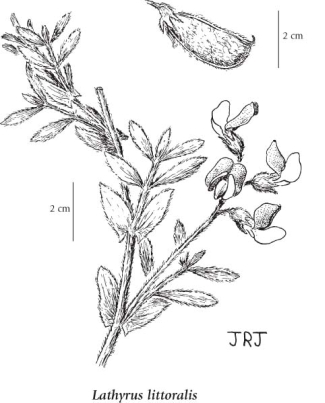grey beach peavine (dune sweet pea; silky beach pea)
Fabaceae (Pea family)
Introduction to Vascular Plants
Introduction
Silky beach pea is a perennial rhizomatous member of the pea family (Fabaceae) that is found in North America in coastal dunes and beaches only along the Pacific Coast (British Columbia, Washington, Oregon and California) (USDA 2011). In British Columbia, this is a red-listed species that is found in only a few locations on Vancouver Island (Saanich Peninsula) and the adjacent Gulf Islands (Sidney Spit), and on Haidai Gwaii. There is one report from Swishwash Island in the mouth of the Fraser River. Plants are prostrate to erect, flowers are a striking combination of purple and white, and leaves are alternate and pinnately compound with 4-8 leaflets. The plant is densely silky-grey, with silky-grey pods.
Although rare in British Columbia, this is a salt-tolerant species that is used in revegetating shoreline areas in the U.S. In BC, it has now been reported from the following BEC zones: CDFmm, CWHvh, CWHwh, CWHxm (BCCDC 2012). |
Species Information
General:
Perennial herb from a wide-spreading rhizome; stems prostrate to erect, 10-60 cm long, angled but not winged, densely grey-silky.
Leaves:
Alternate, pinnately compound with 4 to 8 leaflets; leaflets oblong-lanceolate, 1-2 cm long, grey-silky, the axis 1.5-3 cm long, flattened and prolonged as a broad bristle but not tendril-like; stipules egg- to arrowhead-shaped, equal to or larger than the leaflets, sometimes constricted into upper and lower lobes.
Flowers:
Inflorescence a loose, long-stalked, axillary cluster of 2 to 6 pea-like flowers; corollas 12-18 mm long, the banner pink or red to purple (rarely white), 14-18 mm long, the banner-claw 2/3 as long as the blade, the wings and keel usually white, shorter than the banner; calyces 8-11 mm long, the lanceolate teeth nearly equal in size and about as long as the tube.
Fruits:
Pods, 3 cm long, 1 cm wide, grey silky-hairy; seeds 1 to 5.
Illustration

If more than one illustration is available for a species (e.g., separate illustrations were provided for two subspecies) then links to the separate images will be provided below. Note that individual subspecies or varietal illustrations are not always available.
Illustration Source: The Illustrated Flora of British Columbia
USDA Species Characteristics
Flower Colour:
Purple
Blooming Period:
Spring
Fruit/Seed characteristics:
Colour: Black
Present from Spring to Summer
Source: The USDA
Ecology
The table below shows the species-specific information calculated from
original data (BEC database) provided by the BC Ministry of Forests and Range.
(Updated August, 2013)
| Site Information |
Value / Class |
||
|
Avg |
Min |
Max |
|
| Elevation
(metres) |
5 | 2 | 11 |
| Slope
Gradient (%) |
0 | 0 | 1 |
|
Aspect (degrees) |
0 | ||
| Soil
Moisture Regime (SMR) [0 - very xeric; 4 - mesic; 8 - hydric] |
2 | 1 | 4 |
| Modal
Nutrient Regime
Class |
A | ||
| #
of field plots species was recorded in: |
3 | ||
| Modal
BEC Zone Class |
CWH | ||
|
All BEC Zones (# of stations/zone) species was recorded in |
CWH(3) | ||
|
Source:
Klinkenberg 2013
|
|||
Habitat and Range
Coastal dunes and sand beaches; infrequent, scattered on Vancouver Island and the Queen Charlotte Islands; S to N CA.Status Information
| Origin Status | Provincial Status | BC List (Red Blue List) | COSEWIC |
|---|---|---|---|
| Native | S2 | Red | T (Apr 2013) |
BC Ministry of Environment: BC Species and Ecosystems Explorer.